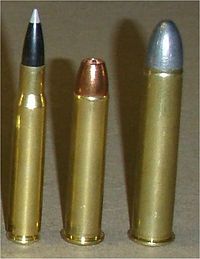| .45-70 Government | ||||||||||||||||||||||||
|---|---|---|---|---|---|---|---|---|---|---|---|---|---|---|---|---|---|---|---|---|---|---|---|---|
 From left, .30-06, .45-70, and .50-90 Sharps | ||||||||||||||||||||||||
| Type | Rifle | |||||||||||||||||||||||
| Place of origin | United States | |||||||||||||||||||||||
| Service history | ||||||||||||||||||||||||
| In service | 1873–1892 | |||||||||||||||||||||||
| Used by | United States | |||||||||||||||||||||||
| Wars | Indian Wars, Spanish–American War, Philippine–American War, Moro Rebellion | |||||||||||||||||||||||
| Production history | ||||||||||||||||||||||||
| Designer | United States Army | |||||||||||||||||||||||
| Designed | 1872 | |||||||||||||||||||||||
| Produced | 1873–present | |||||||||||||||||||||||
| Variants | .45-70 +P | |||||||||||||||||||||||
| Specifications | ||||||||||||||||||||||||
| Case type | Rimmed, straight[1] | |||||||||||||||||||||||
| Bullet diameter | .458 in (11.6 mm) | |||||||||||||||||||||||
| Neck diameter | .480 in (12.2 mm) | |||||||||||||||||||||||
| Base diameter | .505 in (12.8 mm) | |||||||||||||||||||||||
| Rim diameter | .608 in (15.4 mm) | |||||||||||||||||||||||
| Rim thickness | .070 in (1.8 mm) | |||||||||||||||||||||||
| Case length | 2.105 in (53.5 mm) | |||||||||||||||||||||||
| Overall length | 2.550 in (64.8 mm) | |||||||||||||||||||||||
| Primer type | Large rifle | |||||||||||||||||||||||
| Maximum pressure (CIP) | 32,000 psi (220 MPa) | |||||||||||||||||||||||
| Maximum pressure (Original 45-70-405 loading [2]) | 19,000 psi (130 MPa) | |||||||||||||||||||||||
| Maximum pressure (Original 45-70-500 loading [3]) | 25,000 psi (170 MPa) | |||||||||||||||||||||||
| Maximum CUP | 28,000 CUP | |||||||||||||||||||||||
| Ballistic performance | ||||||||||||||||||||||||
| ||||||||||||||||||||||||
| Test barrel length: 32.6"[3] Source(s): Springfield Armory (U.S.) (1874). Description and Rules for the Management of the Springfield Rifle, Carbine, and Army Revolvers, Caliber 45. U.S. Government Printing Office. Springfield Armory (U.S.) (1887). Description and Rules for the Management of the Springfield Rifle, Carbine, and Army Revolvers, Caliber 45. U.S. Government Printing Office. Accurate Powder[6][7][8] | ||||||||||||||||||||||||
The .45-70 (11.6x53mmR), also known as the .45-70 Government, .45-70 Springfield, and .45-21⁄10" Sharps, is a .45 caliber rifle cartridge originally holding 70 grains of black powder that was developed at the U.S. Army's Springfield Armory for use in the Springfield Model 1873. It was a replacement for the stop-gap .50-70 Government cartridge, which had been adopted in 1866, one year after the end of the American Civil War, and is known by collectors as the "Trapdoor Springfield".[citation needed][9]
- ^ Cartridge dimensions.
- ^ Springfield Armory (U.S.) (1874). Description and Rules for the Management of the Springfield Rifle, Carbine, and Army Revolvers, Caliber 45. U.S. Government Printing Office.
- ^ a b c Springfield Armory (U.S.) (1887). Description and Rules for the Management of the Springfield Rifle, Carbine, and Army Revolvers, Caliber 45. U.S. Government Printing Office.
- ^ Springfield Armory (U.S.) (1874). Description and Rules for the Management of the Springfield Rifle, Carbine, and Army Revolvers, Caliber 45. U.S. Government Printing Office.
- ^ Springfield Armory (U.S.) (1887). Description and Rules for the Management of the Springfield Rifle, Carbine, and Army Revolvers, Caliber 45. U.S. Government Printing Office.
- ^ .45-70 data for Trapdoor from Accurate Powder Archived 2009-05-30 at the Wayback Machine.
- ^ .45-70 standard data from Accurate Powder Archived 2009-05-30 at the Wayback Machine.
- ^ .45-70 data for Strong actions from Accurate Powder Archived 2007-09-30 at the Wayback Machine.
- ^ "Sharps rifle terms & cartridges: setting the record straight.." The Free Library. 2010 Publishers' Development Corporation 07 Jul. 2023 https://www.thefreelibrary.com/Sharps+rifle+terms+%26+cartridges%3a+setting+the+record+straight.-a0270372105